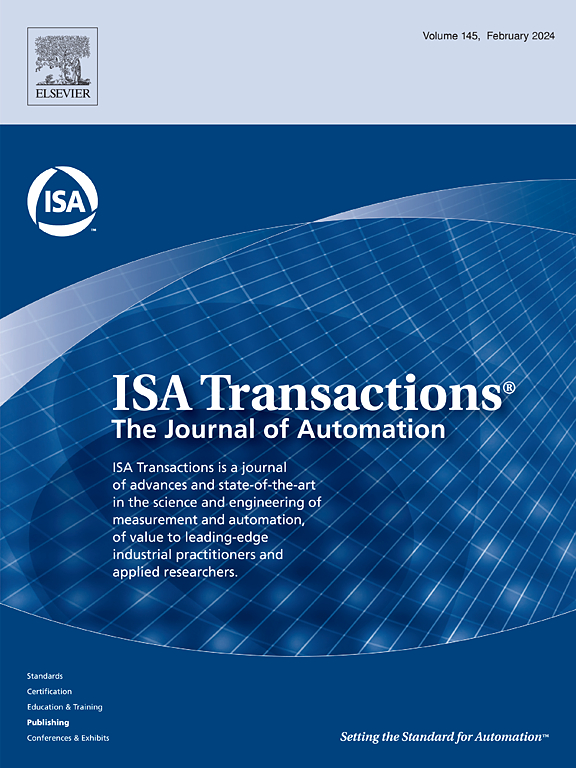A composite fixed-time sliding mode control scheme for Unmanned Ground Vehicles affected by external disturbances
IF 6.5
2区 计算机科学
Q1 AUTOMATION & CONTROL SYSTEMS
引用次数: 0
Abstract
Accurate path-following control is crucial for Unmanned Ground Vehicles (UGV). However, influenced by external disturbances, UGV systems encounter challenges in meeting specific performance requirements, such as no overshoot and minimized chattering. In current sliding mode control (SMC) methods with disturbance observer (DOB), there still exists a serious chattering problem. To achieve fast chattering reduction and accurate path-following performance, this paper proposes a novel composite fixed-time sliding mode (CFTSM) control method according to fixed-time disturbance observer (FTDO). First, a innovative CFTSM control scheme is developed to achieve a significant gain near the origin in the UGV system. It facilitates quicker convergence and improved tracking performance than other SMC methods. Then, to mitigate the impact of the external disturbances, a FTDO is designed to estimate and effectively eliminate these disturbances in fixed-time. Finally, a composite control strategy, which integrated the FTDO into the CFTSM control scheme, is proposed to stabilize the UGV system and suppress the chattering phenomenon. A comprehensive simulation and experimental results demonstrate that the proposed CFTSM-FTDO control strategy performs better with strong robustness and stability. In real experiments, the CFTSM achieves RMSE reductions of 26.8% and 8.9% in lateral and heading errors compared to CFTSM-FFE, and 19.1% and 3.9% compared to FTSMC-AESO. These enhancements are expected to achieve more accurate and stable tracking performance for the UGV, thus giving rise to accurate autonomous navigation.
受外部干扰影响的无人地面飞行器的复合固定时间滑动模式控制方案。
精确的路径跟踪控制对无人地面飞行器(UGV)至关重要。然而,受外部干扰的影响,UGV 系统在满足特定性能要求方面遇到了挑战,例如无过冲和颤振最小化。在当前使用干扰观测器(DOB)的滑模控制(SMC)方法中,仍然存在严重的颤振问题。为了实现快速减少颤振和精确的路径跟随性能,本文提出了一种基于定时扰动观测器(FTDO)的新型复合定时滑模(CFTSM)控制方法。首先,开发了一种创新的 CFTSM 控制方案,以实现 UGV 系统在原点附近的显著增益。与其他 SMC 方法相比,它收敛更快,跟踪性能更好。然后,为了减轻外部干扰的影响,设计了一种 FTDO,用于在固定时间内估计并有效消除这些干扰。最后,提出了一种将 FTDO 集成到 CFTSM 控制方案中的复合控制策略,以稳定 UGV 系统并抑制颤振现象。综合仿真和实验结果表明,所提出的 CFTSM-FTDO 控制策略具有较好的鲁棒性和稳定性。在实际实验中,与 CFTSM-FFE 相比,CFTSM 的横向误差和航向误差的均方根误差分别降低了 26.8% 和 8.9%;与 FTSMC-AESO 相比,CFTSM 的均方根误差分别降低了 19.1% 和 3.9%。这些改进有望为 UGV 实现更精确、更稳定的跟踪性能,从而实现精确的自主导航。
本文章由计算机程序翻译,如有差异,请以英文原文为准。
求助全文
约1分钟内获得全文
求助全文
来源期刊

ISA transactions
工程技术-工程:综合
CiteScore
11.70
自引率
12.30%
发文量
824
审稿时长
4.4 months
期刊介绍:
ISA Transactions serves as a platform for showcasing advancements in measurement and automation, catering to both industrial practitioners and applied researchers. It covers a wide array of topics within measurement, including sensors, signal processing, data analysis, and fault detection, supported by techniques such as artificial intelligence and communication systems. Automation topics encompass control strategies, modelling, system reliability, and maintenance, alongside optimization and human-machine interaction. The journal targets research and development professionals in control systems, process instrumentation, and automation from academia and industry.
 求助内容:
求助内容: 应助结果提醒方式:
应助结果提醒方式:


